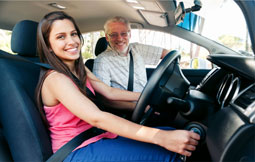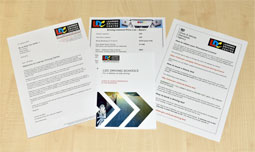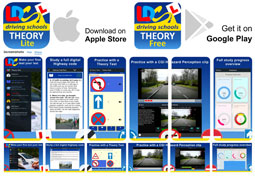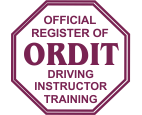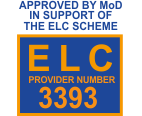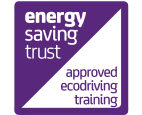The Driving Test
Introduction
You have now completed the programme and should have the necessary driving skills to pass the UK driving test. However, before you take the test it's important that you understand how the test works so that you do not get any surprises on the day. To do this your instructor will simulate a full driving test and act like an examiner. Therefore the purpose of this driving lesson is to make you comfortable with the driving test itself and identify any final driving weaknesses you may have.
Key learning points
To keep up to date with the latest driving test information from the The Driver and Vehicle Standards Agency please visit https://www.gov.uk/driving-test
The Driver and Vehicle Standards Agency driving test for car drivers is about 40 minutes long or 70 minutes if you are doing an extended driving test. During this time the examiner will expect you to satisfy the eyesight test, show and tell him how to undertake certain vehicle safety checks and demonstrate an ability to drive the car safely around a given test route. The route will encompass a wide variety of different road conditions and at various points along the way the examiner will also require you to complete certain test manoeuvres.
There are 5 parts to the driving test:
- an eyesight check
- ‘show me, tell me’ vehicle safety questions
- general driving ability
- reversing your vehicle
- independent driving
The test is the same for both manual and automatic cars.
Driving on the test is a little different from driving with your driving instructor on a driving lesson. The most obvious difference is that the examiner is not going to help you with your driving or your answers to the “show me tell me” part of the test. However, the examiner will be happy to clarify any instruction they may have given to you. The examiner will also try to put you at ease, as the last thing that they want is to make you feel unnecessarily anxious. The examiner wants to test your driving ability not your nerve.
Therefore don't be surprised at how friendly they are. You may find that your examiner offers encouragement or advice in regard to your test nerves. Once the examiner has introduced themselves, they will ask you to read a number plate at the required distance. Assuming that you are able to do this, the examiner will ask you to show the way to your vehicle where they will check its condition before entering the vehicle. At this point the examiner will ask you two questions, one ‘show me’ and one ‘tell me’. One or both questions answered incorrectly will result in one minor driving fault being recorded. If the “show me” question requires you to open the bonnet this question will be asked before you get into the vehicle otherwise the “show me tell me” part of the test will commence after you have entered the vehicle.
You will then start the driving part of the driving test. While still in the car park the examiner may ask you to pull forward and complete the bay park exercise or drive out straight onto the road. The examiner will tell you in good time which way to go. If you go the wrong way do not panic the examiner is testing your ability to drive not your ability to follow directions. It is better to go the wrong way correctly than to go the right way incorrectly. If at any time you are unsure what the examiner requires do not hesitate to check what they want; the examiner appreciates that you may be nervous and will be happy to repeat or clarify any instructions given. At certain points on the route the examiner may ask you to complete a set manoeuvre.
As soon you are asked to move off the examiner will start to assess your driving ability, noting any driving faults you may commit on the Driving Test Report – the DL25. There are three types of fault that you can commit – minor, serious or dangerous. A serious or a dangerous fault will result in a test failure. An accumulation of more than 15 minor driving faults will also result in a test failure.
![]() If a minor fault is committed the examiner denotes this by a ‘/’ slash in the first box against the appropriate report heading. At the end of the test the examiner will use the second box to denote the total number of minor driving faults against that heading. If a serious fault is committed the examiner will denote this by placing a ‘/’ in the third box against the appropriate heading. Finally, if a dangerous fault is committed the examiner will denote this by placing a ‘/’ in the fourth box against the appropriate heading.
If a minor fault is committed the examiner denotes this by a ‘/’ slash in the first box against the appropriate report heading. At the end of the test the examiner will use the second box to denote the total number of minor driving faults against that heading. If a serious fault is committed the examiner will denote this by placing a ‘/’ in the third box against the appropriate heading. Finally, if a dangerous fault is committed the examiner will denote this by placing a ‘/’ in the fourth box against the appropriate heading.
A dangerous fault results in test failure because the examiner or another road user had been forced to take evasive action to avoid an accident.
A serious fault results in test failure because the fault affected another road user or had the potential to affect another road user.
A minor fault does not result in a test failure because it would not normally cause an accident but could be a contributing factor in certain circumstances. Fifteen or more such faults would suggest that the candidate was lucky not to have committed a serious or dangerous fault and should therefore fail the test.
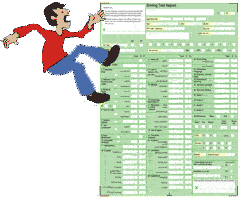 Common Driving Faults
Common Driving Faults
On the following pages you will see a list of common faults recorded by examiners under each of the headings shown. Use this as a guide to help you determine what, if any, driving weaknesses you may still have.
1.COMPLY WITH REQUIREMENTS OF EYESIGHT TEST:
Unable to read a number plate at 67 feet or 20.5 metres which is about five car lengths.
2.TAKE PRECAUTIONS BEFORE STARTING THE ENGINE:
Jumping forward while attempting to start the engine with the car in gear.
Rolling backwards or forwards while attempting to restart the engine.
3.MAKE PROPER USE OF:
ACCELERATOR:
Excessive pressure causing wheel spin.
Erratic pressure causing surging.
Not removing pressure while changing gear.
Applying pressure too soon after changing gear.
CLUTCH:
Jerky control.
Lack of control.
Releases too quickly.
Riding the pedal.
Not pressing fully to the floor.
Not used when stopping.
HANDBRAKE:
Not applying when necessary.
Not releasing properly.
Moving away with it partially on.
Not applying properly.
Applying on the move.
Rolling backwards or forwards after stopping.
GEARS:
Incorrect gear selection.
Reluctant to select higher gears.
Labours the engine.
Does not match gear with road speed.
Excessive speed in gear.
Unnecessary gear changes.
Used to reduce speed instead of brakes.
Selected too soon for hazards.
Selected too late for hazards.
Coasting with clutch down.
Coasting in neutral.
FOOT BRAKE:
Not used when required.
Late use on approach to hazards.
Harsh use by pressing too fiercely.
STEERING:
Incorrect hand position on the wheel.
Losing control by crossing hands.
Allowing wheel to spin back after turning.
Retaining hand on the gear lever for too long.
Removes both hands from steering wheel.
Overshooting right turns.
Over steers on corners.
Under steers on corners.
Steering with the right arm on the window ledge.
Striking the kerb when stopping.
4.MOVE AWAY:
SAFELY:
No attempt to look around.
Lack of observation ahead and to the rear.
Moves away when unsafe.
UNDER CONTROL:
Stalls the engine.
Moving away at too high a speed.
Rolls back.
5.STOP THE VEHICLE IN AN EMERGENCY:
PROMPTLY:
Slow reaction to signal.
Not stopping quickly enough.
UNDER CONTROL:
Uses foot brake and clutch together.
Clutch pedal used too soon.
Harsh application of foot brake.
Uses handbrake to stop.
Locks front or rear wheels.
Induces a skid by braking and steering at the same time.
Loses control by skidding.
6.REVERSE INTO A LIMITED OPENING TO THE RIGHT OR LEFT:
UNDER CONTROL:
Poor clutch control.
Stalls the engine.
Excessive acceleration.
Foot brake not used when required.
Erratic use of steering.
Touches kerb.
Mounts pavement.
Over centre of the side road.
Unable to enter side road.
Too far from kerb at completion.
Car not parallel to the kerb.
WITH PROPER OBSERVATION:
Does not look out of rear window.
Does not take all around observation throughout.
Uses nearside door mirror for observation.
Does not observe other road users.
Does not give way to other road users.
Does not pull forwards to allow vehicle to emerge from the side road.
7.TURN IN THE ROAD:
UNDER CONTROL:
Poor clutch control.
Stalls the engine.
Excessive acceleration.
Harsh use of foot brake.
Not applying the handbrake properly.
Strikes kerbs with front or rear wheels.
Mounts pavement with front or rear wheels.
Overhangs the kerb with front or rear of car.
Unable to complete exercise within five moves.
Turns the steering wheel in the wrong direction.
No attempt to correct steering on forward or reverse moves.
WITH PROPER OBSERVATION:
Lack of all round observation before moving.
Moves forwards or backwards when unsafe to do so.
Does not look to the rear while reversing.
Only looks back over one shoulder while reversing.
Lack of all round observation during each movement.
Continues with movement, does not give way to passing traffic.
Does not allow pedestrians to proceed safely on the pavements.
8.REVERSE PARK:
UNDER CONTROL:
Poor clutch control.
Stalls the engine.
Excessive acceleration.
Insufficient or excessive steering.
Harsh use of foot brake.
Too close to parked car.
Strikes the kerb with front or rear nearside wheel.
Too far away from the left hand kerb at completion.
Car finishes up at an angle to the kerb.
Unable to complete within two car lengths.
WITH PROPER OBSERVATION:
Does not take all round observation before exercise.
Does not look out of the rear window while reversing.
Uses door mirror to observe while reversing.
Ignores passing traffic and does not give way.
Reverses with pedestrians passing by on the pavement at rear.
9.MAKE EFFECTIVE USE OF MIRROR(S) WELL BEFORE:
SIGNALLING:
Does not use Mirror Signal Manoeuvre routine.
Signals before using mirrors.
Looks and signals at the same time.
Does not take appropriate action after observing traffic in mirrors.
Signals regardless of following traffic situation.
CHANGING DIRECTION:
Does not consult mirrors before turning left.
Does not consult mirrors before turning right.
Does not consult mirrors before changing lanes.
Does not consult mirrors before overtaking.
Does not consult mirrors after overtaking
CHANGING SPEED:
Does not consult mirrors before increasing speed.
Does not consult mirrors before reducing speed.
Does not consult mirrors before stopping.
10.GIVE SIGNALS:
WHERE NECESSARY:
Omits signals when they could benefit other road users.
CORRECTLY:
Gives signals in the wrong direction.
Gives misleading signals.
Does not cancel signals after completion of manoeuvre.
Using any signal not in the highway code.
PROPERLY TIMED:
Give signals too early.
Gives signals too late.
Signals for too short a period of time.
Signals for too long a period of time.
11a. TAKE CORRECT AND PROMPT ACTION ON ALL:
TRAFFIC SIGNS:
Disregards speed limit signs.
Does not obey mandatory signs.
Ignores prohibiting signs.
Ignores warning signs.
ROAD MARKINGS:
Does not act in accordance with lane direction arrows.
Crosses or straddles double white lines.
Drives in bus lanes at prohibited times.
Parks on double yellow lines.
Disregards box junction markings.
Stops on worded markings such as “Keep Clear”.
Parks on zigzag lines.
TRAFFIC LIGHTS:
Attempts to drive through a red light.
Does not stop on amber when it was safe to do so.
Drives away on red and amber.
Proceeds on green light when unsafe to do so.
11b. TAKE CORRECT AND PROMPT ACTION ON ALL SIGNALS BY:
TRAFFIC CONTROLLERS:
Disregards signals given by police or a traffic warden.
Disregards signals given by a person in charge of road works with Stop/Go sign.
Disregards signal given by School Crossing Patrol.
OTHER ROAD USERS:
Disregards clearly given signals by other drivers.
12.EXERCISE PROPER CARE IN THE USE OF SPEED:
Drives in excess of the speed limit.
Drives at a speed which is too fast for the road and traffic conditions.
13.FOLLOW BEHIND ANOTHER VEHICLE AT A SAFE DISTANCE:
Drives too close to large vehicles ahead.
Does not adopt the two second rule.
Drives closer than thinking distance in heavy traffic.
Stops too close to vehicles ahead in traffic queues.
14.MAKES PROGRESS BY:
DRIVING AT A SPEED APPROPRIATE TO THE ROAD:
Crawls along at slow speeds on clear roads.
Makes no attempt to achieve maximum speeds for the road when safe to do so.
Reduces speed excessively when the conditions do not merit doing so.
Makes slow progress through the gears in normal driving.
AVOIDING UNDUE HESITANCY:
Makes predetermined stops at junctions and other hazards.
Waits unnecessarily when it is safe to proceed at junctions.
Waits for green light at pedestrian crossings when clear on flashing amber.
Waits for other drivers, who are clearly giving way.
15.ACT PROPERLY AT ROAD JUNCTION WITH REGARD TO:
SPEED ON APPROACH:
Approaches at too high a speed.
Approaches at too slow a speed.
OBSERVATION:
Only looks in one direction at junctions before emerging.
Looks in both directions after emerging.
Does not look in the direction of travel while emerging.
Takes no observation whatsoever at unmarked crossroads.
Emerges at too slow a speed.
Emerges when traffic is too close or too fast.
Emerges into the path of approaching traffic.
POSITION BEFORE TURNING RIGHT:
Positions over centre lines.
Positions left of centre in narrow roads.
Does not position near enough to centre lines.
Does not move into protected centre lane.
Does not use right hand lane, when one is available.
Does not proceed far enough forward when giving way to oncoming traffic.
Does not move out to centre of the side road when turning right at traffic lights.
Sits behind stop line at green light, with room to move forwards.
POSITION BEFORE TURNING LEFT:
Too far from left hand kerb on the approach.
Swings out to the right on the approach.
Too close to the kerb on approach.
Drives over the kerb with rear nearside wheel.
CUTTING RIGHT HAND CORNERS:
Cuts across onto the wrong side of side road while turning the corner.
16.DEAL WITH OTHER VEHICLES SAFELY WHEN:
OVERTAKING:
Attempts to overtake in an unsafe location.
Attempts to overtake when traffic conditions make it unsafe to do so.
Takes too long a time and distance to carry out manoeuvre.
Does not give enough clearance to other vehicles.
Cuts back in too soon after overtaking.
MEETING:
Causes oncoming traffic to slow down or stop.
Drives on towards other vehicles when other vehicles have priority.
CROSSING THEIR PATH:
Inconveniences oncoming road users by cutting across in front of them.
17.POSITION THE VEHICLE CORRECTLY:
DURING NORMAL DRIVING:
Drives too close to the left hand kerb.
Drives too far out towards the middle of the road.
EXERCISE LANE DISCIPLINE:
Chooses incorrect lane when proceeding ahead at roundabouts or traffic lights.
Straddles lane markings.
Wanders back and forwards from one lane to the other.
18. ALLOW ADEQUATE CLEARANCE TO STATIONARY VEHICLES:
Drives too close to the rear of stationary vehicles before pulling out.
Drives too close to the side of stationary vehicles while driving past.
Cuts back to the left too soon after passing stationary vehicles.
19. TAKE APPROPRIATE ACTION AT PEDESTRIAN CROSSINGS:
Does not reduce speed on the approach when vision is restricted.
Approaches at too high a speed with pedestrians on crossing.
Overtaking on zigzag lines on approach.
Not giving precedence to pedestrians on a crossing.
Not stopping at give way or stop lines when necessary.
Not acting in accordance with the traffic lights controlling the crossing.
Harassing pedestrians.
Waving pedestrians over a crossing.
Moving away before pedestrians have crossed over in front of the car.
Attempting to proceed when unsafe to do so.
Stopping on the actual crossing.
20.SELECT A SAFE POSITION FOR NORMAL STOPS:
Stopping in an unsafe or inconvenient location.
Blocking an entrance or driveway when stopping.
Causing an obstruction to other road users..
Stopping too far away from the pavement.
Stopping with one or more wheels on the pavement.
21.SHOW AWARENESS AND ANTICIPATION OF THE ACTIONS OF:
OTHER ROAD USERS:
Not anticipating that pedestrians are about to cross the road at any time.
Not giving way to pedestrians at junctions or pedestrian crossings.
Not anticipating that cyclists may be passing on the left or right.
Not anticipating that cyclists are about to make a change of direction.
Not anticipating or showing awareness of direction signals given by other drivers.
Not anticipating or showing awareness of vehicles displaying hazard flashers.
Not anticipating or showing awareness of vehicles reversing lights.
Not anticipating or showing awareness of brake lights on other vehicles.
Not anticipating the actions of other drivers changing speed or direction.
22.USE OF ANCILLARY CONTROLS
Only applicable if driver requires to use them in addition to the normal controls.
Not operating the front or rear windscreen wipers or washers when required.
Not operating the side or headlamp controls when required.
Not operating the horn when required.
Not operating the heated rear screen control when required.
Not operating the demister controls when required.
Not operating the hazard warning lights when required.
Marking Sheet
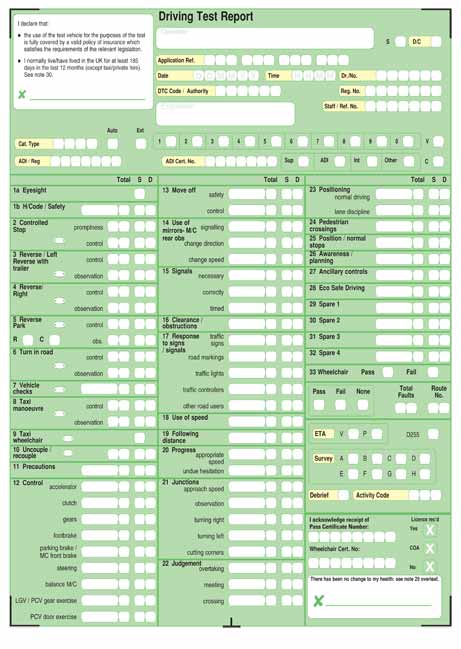
Highway code practical references
Page 125 section 5 Penalties
Page 128 section 6 Vehicle maintenance, safety and security.

